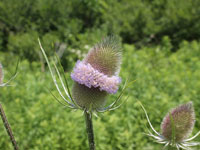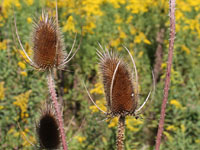![]()
Wild Teasel is a species of flowering plant in the honeysuckle family. Wild Teasel is native to Eurasia and North Africa, but it is known in the Americas, southern Africa, Australia and New Zealand as an introduced species and often a noxious weed. The genus name is derived from the word for thirst and refers to the cup-like formation made where sessile leaves merge at the stem. Rain water can collect in this receptacle; this may perform the function of preventing sap-sucking insects such as aphids from climbing the stem. A recent experiment has shown that adding dead insects to these cups increases the seed set of teasels (but not their height), implying partial carnivorous behaviour.
![]()
Historically wild teasel was used in textile processing, providing a natural comb for cleaning, aligning and raising the nap on fabrics, particularly wool. The seeds are an important winter food resource for some birds, notably the European Goldfinch. Teasels are often grown in gardens and encouraged on some nature reserves to attract them.
![]() Within the realm of naturopathic medicine and folklore, teasel has little use in modern herbal medicine, and its therapeutic effects have been disputed. Traditionally wild teasel has been used to treat conditions such as warts, fistulae (abnormal passages opening through the skin) and cancerous sores. The root is diaphoretic, diuretic and stomachic. An infusion is said to strengthen the stomach, create an appetite, remove obstructions of the liver and treat jaundice. The root is harvested in early autumn and dried for later use. An infusion of the leaves has been used as a wash to treat acne. The plant has a folk history of use in the treatment of cancer, an ointment made from the roots is used to treat warts, wens and whitlows. A homeopathic remedy is made from the flowering plant. It is used in the treatment of skin diseases.
Within the realm of naturopathic medicine and folklore, teasel has little use in modern herbal medicine, and its therapeutic effects have been disputed. Traditionally wild teasel has been used to treat conditions such as warts, fistulae (abnormal passages opening through the skin) and cancerous sores. The root is diaphoretic, diuretic and stomachic. An infusion is said to strengthen the stomach, create an appetite, remove obstructions of the liver and treat jaundice. The root is harvested in early autumn and dried for later use. An infusion of the leaves has been used as a wash to treat acne. The plant has a folk history of use in the treatment of cancer, an ointment made from the roots is used to treat warts, wens and whitlows. A homeopathic remedy is made from the flowering plant. It is used in the treatment of skin diseases.
Please note that MIROFOSS does not suggest in any way that plants should be used in place of proper medical and psychological care. This information is provided here as a reference only.
![]()
There is currently no confirmed data on the edibility of wild teasel.
Please note that MIROFOSS can not take any responsibility for any adverse effects from the consumption of plant species which are found in the wild. This information is provided here as a reference only.
![]()
Wild teasel can go along roadsides, rough pasture, waste places, edges of woodlands, and grows especially well on clay soils. Wild teasel is suitable for light (sandy), medium (loamy) and heavy (clay) soils and can grow in heavy clay soil. Wild teasel cannot grow in the shade and prefers moist soil.
| Soil Conditions | |
| Soil Moisture | |
| Sunlight | |
| Notes: |
![]()
Teasels are easily identified with their prickly stem and leaves, and the inflorescence of purple, dark pink or lavender flowers that form a head on the end of the stem(s). The inflorescence is ovoid, 4cm to 10cm long and 3cm to 5cm wide, with a basal whorl of spiny bracts. The first flowers begin opening in a belt around the middle of the spherical or oval flower head, and then open sequentially toward the top and bottom, forming two narrow belts as the flowering progresses. The dried head persists afterwards, with the small 4mm to 6mm seeds maturing in mid autumn. The flowers are hermaphrodite (have both male and female organs) and are pollinated by bees, self. The plant is self-fertile and is noted for attracting wildlife. The leaf shape is lanceolate, 20cm to 40cm long and 3cm to 6cm wide, with a row of small spines on the underside of the midrib.
![]()
| Plant Height | 60cm to 180cm | 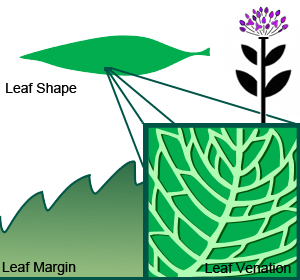 |
| Habitat | Old Fields, Roadsides, Wasteplaces | |
| Leaves | Lanceolate, 20cm to 40cm long and 3cm to 6cm wide | |
| Leaf Margin | Serrate | |
| Leaf Venation | Cross-venulate | |
| Stems | Straight stalks with small sharp thistles | |
| Flowering Season | July to October | |
| Flower Type | Rounded clusters of flowers with each tubular calyx being less then 1.5cm long | |
| Flower Colour | Pink to Lavender | |
| Pollination | Insects; specifically bees | |
| Flower Gender | Flowers are hermaphrodite and the plants are self-fertile | |
| Fruit | Small seeds with no visible pappus | |
| USDA Zone | 4A (-31.7°C to -34.4°C) cold weather limit |
![]()
The following health hazards should be noted when handling or choosing a location to wild teasel:
 |
SHARP THORNS Teasel plants have sharp thorns along the stem and can cause injury is mishandled. |
![]()
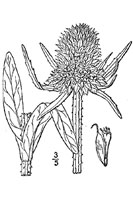 |
-Click here- or on the thumbnail image to see an artist rendering, from The United States Department of Agriculture, of wild teasel. (This image will open in a new browser tab) |
![]()
 |
-Click here- or on the thumbnail image to see a magnified view, from The United States Department of Agriculture, of the seeds created by the wild teasel for propagation. (This image will open in a new browser tab) |
![]()
Wild Teasel can be referenced in certain current and historical texts under the following two names:
Wild Teasel can be translated into the following select languages:
| Arabic | ممشقة | Bulgarian | лугачка | Chinese (Sim) | 起毛草 |
| Croatian | češljati | Czech | pcháč | Danish | |
| Dutch | kaarde | Esperanto | Cardon | Estonian | uniohakas |
| Finnish | French | cardère | German | Karde | |
| Greek | νεράγκαθο | Hebrew | Hungarian | takácsmácsonya | |
| Italian | cardo | Japanese | オニナベナ | Korean | 산토끼 꽃 |
| Low Saxon | Lithuanian | karšti | Norwegian | ||
| Persian | شانه زدن | Polish | oset | Portuguese | carda |
| Romanian | scărmăna | Russian | ворсянка | Slovak | pichliač |
| Spanish | carda | Swedish | Tagalog | magtisel | |
| Turkish | tarakotu | Ukrainian | черсак | Vietnamese | cây sơn cần |
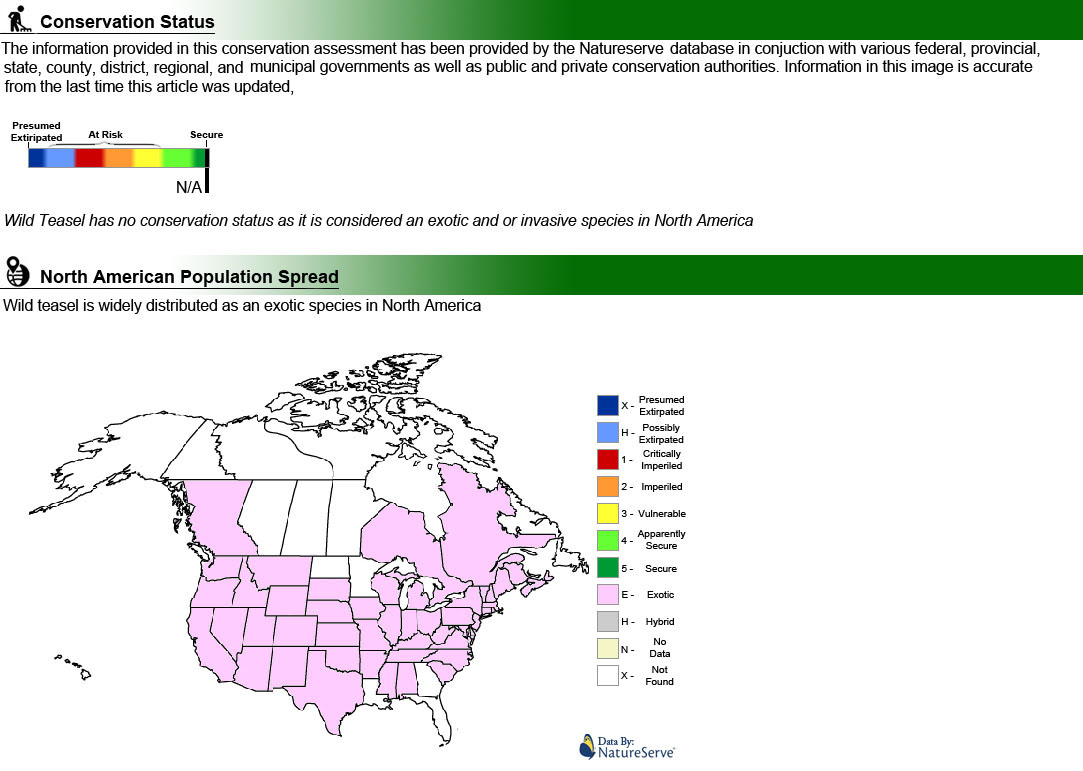
![]()
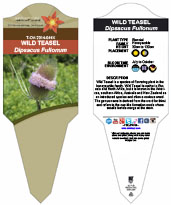 |
The MIROFOSS database offers free printable garden tags for personal and non-profit use. These tags can be used to properly identify plant samples in a garden. Click on the tags shown on the the screen or -click here- to download a full size jpeg image for a wild teasel identification tag; which can be printed on paper or used with a plastic laser printer. |
 |
What's this? What can I do with it? |
![]()
| Background | "BSBI List 2007". Botanical Society of Britain and Ireland. |
| Background | Dickinson, R.; Royer, F.; (2014) Plants of Southern Ontario. ISBN 978-1-55105-906-8 |
| Background | "Teasel." The Oxford English Dictionary. 2nd ed. 1989. |
| Biology | Shaw, P. J. A.; Shackleton, K. (2011). Joly, Simon, ed. "Carnivory in the teasel Dipsacus fullonum — the effect of experimental feeding on growth and seed set" |
| Biology | Dickinson, T.; Metsger, D.; Bull, J.; & Dickinson, R. (2004) ROM Field Guide to Wildflowers of Ontario, Royal Ontario Museum, Toronto:McClelland and Stewart Ltd. |
| Environment | National Audubon Society. Field Guide To Wildflowers (Eastern Region): Alfred A. Knopf. ISBN 0-375-40232-2 |
| Physical Identification | National Audubon Society. Field Guide To Wildflowers (Eastern Region): Alfred A. Knopf. ISBN 0-375-40232-2 |
| April 25, 2015 | The last time this page was updated |
| ©2025 MIROFOSS™ Foundation | |
 |
|

